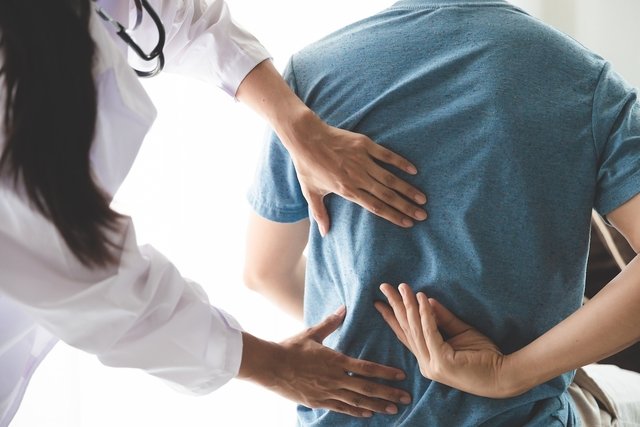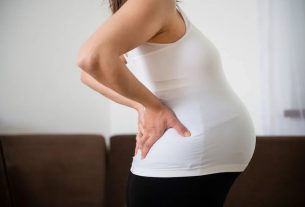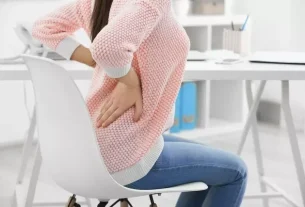Pain in the middle of the back is generally related to spinal problems and can be a sign of poor posture, herniated disc, osteoarthritis and even small fractures.
However, in some cases, this type of pain can also occur when there is some change in an organ located in this region, such as the lungs, heart or stomach, and a medical evaluation is important.
The ideal is to consult a general practitioner whenever the pain does not improve, is very intense or is accompanied by symptoms such as tiredness, shortness of breath or fainting, for example. The doctor will identify the possible cause of the pain and recommend the best specialist to provide the appropriate treatment.
What can be pain in the middle back
The main causes of pain in the middle back are:
1. Bad posture
Poor posture throughout the day is one of the main causes of pain in various parts of the back, especially when you spend a lot of time sitting with your back bent. This happens because the spine is subjected to constant pressure, which ends up overloading the back muscles and ligaments, resulting in constant pain.
What to do: It is best to always maintain correct posture throughout the day, but this tip is even more important for those who work with their back constantly bent. See some exercises that help strengthen your back to alleviate this type of pain.
2. Muscle injury or contracture
Along with poor posture, muscle injuries and contractures are another major cause of mid-back pain. This type of injury is more common in people who train with very heavy weights, but it can also happen at home, when you try to pick up a very heavy object, using only your back.
What to do: you must rest and to alleviate the pain you can apply a hot water bottle to relax the affected muscles. Additionally, massaging the area also helps reduce inflammation and improve discomfort. Check out other tips for treating a muscle contracture.
3. Herniated disc
A herniated disc happens when the disc between the vertebrae suffers some change, causing constant pain that worsens when moving the back. Furthermore, there may also be a tingling or burning sensation in the back of one of the arms or legs, as it can radiate to other parts of the body.
A hernia usually appears as a consequence of poor posture over a long period of time, but it can also develop from picking up very heavy objects without protecting your back. Know all the causes of herniated discs and their symptoms.
What to do: if a herniated disc is suspected, an orthopedist should be consulted to assess the change that has occurred in the disc between the vertebrae and initiate the most appropriate treatment, which may include anything from the use of analgesics and anti-inflammatory medications, to surgery.
4. Osteoarthritis
Although it is rarer, osteoarthritis can also be an important cause of pain in the middle of the back, as this disease causes the gradual degradation of the cartilage between the vertebrae. When this happens, the bones end up rubbing against each other, causing pain, which gets worse over time.
What to do: you should go to the orthopedist to confirm the diagnosis and, if necessary, start treatment with physiotherapy sessions. If this type of treatment is not enough to alleviate the pain, the doctor may consider surgery. Learn more about how physiotherapy for osteoarthritis is performed.
5. Minor spinal fractures
As we age, bones become more fragile and, therefore, it is common for small fractures to appear in the vertebrae of the spine, especially after some type of accident, fall or blow to the back. The pain that arises with the fracture can be very intense and appear immediately after the trauma, but it can also appear gradually.
In addition to pain, a small fracture in the spine can also cause tingling in other parts of the body, such as arms, hands or legs, for example.
What to do: although most fractures are very small, they can end up developing if there is no adequate treatment. Therefore, if a fracture is suspected, an appointment with an orthopedist should be made. Until the consultation, the ideal is to avoid putting too much effort on your back. See which treatment options are most commonly used in the case of a spinal fracture.
6. Lung problems
Sometimes, back pain may not be directly related to the spine or back muscles, and may arise when there are lung problems, especially when the pain appears or becomes more intense when breathing. In these cases, other symptoms associated with breathing may also appear, such as shortness of breath or persistent cough.
What to do: if back pain is associated with other signs of lung problems, you should consult a general practitioner or a pulmonologist to identify whether there is any change or infection in the lung that needs to be treated.
7. Stomach problems
Similar to the lung, when the stomach is affected by some change, such as reflux or ulcer, for example, the pain can radiate to the middle of the back. However, in this situation, people also tend to experience a burning sensation in the throat, difficulty digesting and even vomiting.
What to do: When you suspect that back pain could be a sign of a stomach problem, you should go to the gastroenterologist. Until the consultation, the most important thing is to maintain a healthy diet, with little fried food, fat or sugar, as well as using digestive teas, for example. Check out some natural ways to relieve stomach pain while you wait for your appointment.
When to go to the doctor
In most cases, mid-back pain is not a sign of a serious problem. However, as this pain can also be associated with urgent situations such as a heart attack, it is advisable to go to the hospital if other symptoms appear, such as:
- Feeling of tightness in the chest;
- Fainting;
- Intense difficulty breathing;
- Difficulty walking.
Furthermore, if the pain takes more than 1 week to disappear, you should go to a general practitioner or orthopedist to identify the cause and start the most appropriate treatment.

Sign up for our newsletter and stay up to date with exclusive news
that can transform your routine!
Warning: Undefined array key "title" in /home/storelat/public_html/wp-content/plugins/link-whisper-premium/templates/frontend/related-posts.php on line 12
Warning: Undefined array key "title_tag" in /home/storelat/public_html/wp-content/plugins/link-whisper-premium/templates/frontend/related-posts.php on line 13




